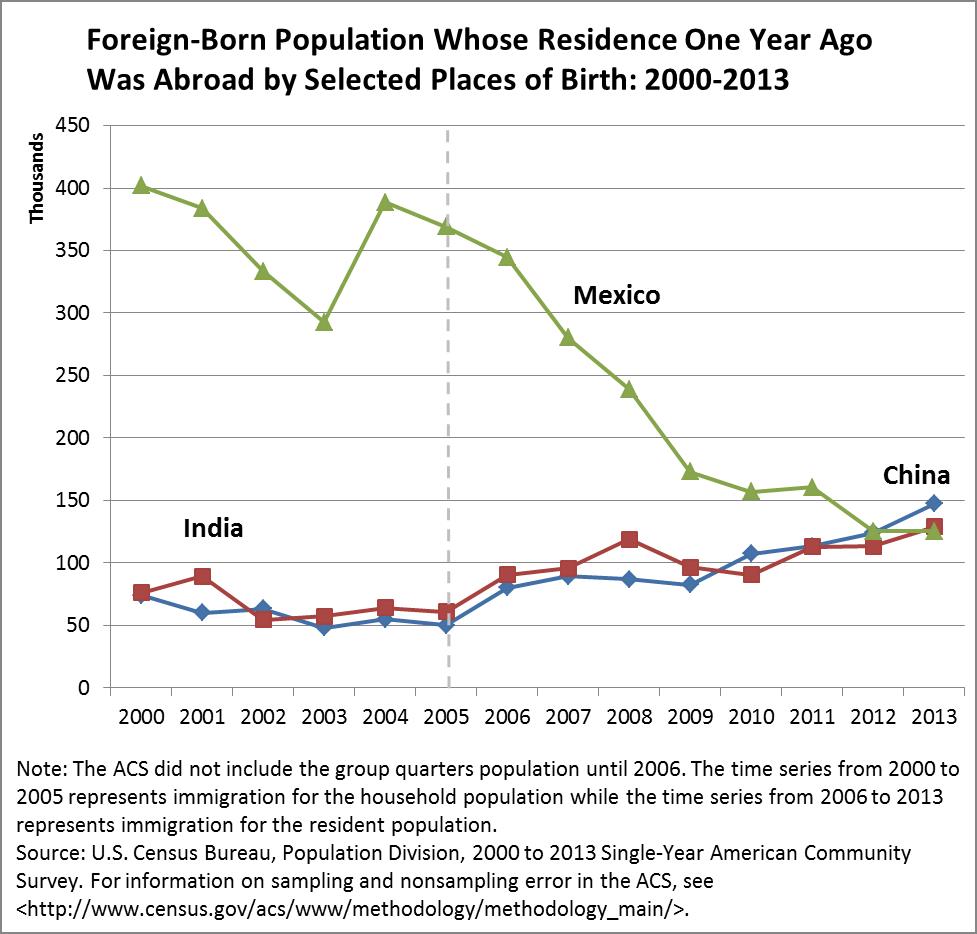
An official website of the United States government
Here’s how you know
Official websites use .gov
A .gov website belongs to an official government organization in the United States.
Secure .gov websites use HTTPS
A lock (
) or https:// means you’ve safely connected to the .gov website. Share sensitive information only on official, secure websites.
-
//
- Census.gov /
- Newsroom /
- Census Blogs /
- Research Matters /
- China Passes Mexico as Top Sending Country of Immigrants to the US
China Replaces Mexico as the Top Sending Country for Immigrants to the United States
China Replaces Mexico as the Top Sending Country for Immigrants to the United States
Note: Census Bureau experts are presenting on a variety of topics at the Population Association of America annual conference. Follow the Research Matters blog or visit the press kit to learn more about their work.
Based on my research, in 2013, China replaced Mexico as the top sending country for immigrants to the United States. This followed a decade where immigration from China and India increased while immigration from Mexico decreased. Other top immigrant-sending countries in 2013 from Asia included Korea, the Philippines and Japan. This new pattern in the national origins of recent immigrants is a notable change from recent decades.
The racial and ethnic composition of immigration flows to the United States has also been shifting. In 2000, nearly half of all foreign-born immigrants, 41.2 percent, were Hispanic, compared with 23.6 percent for the non-Hispanic Asian alone population. Since 2009, a greater proportion of foreign-born immigrants have been non-Hispanic Asian alone (34.7 percent) than Hispanic (30.1 percent). By 2013, the percentage of non-Hispanic Asian alone had increased to 40.2 percent of the total immigration flow, while the percentage Hispanic had dropped to 25.5 percent.
The U.S. Census Bureau’s Population Estimates Program measures net international migration, including the foreign-born population whose residence one year ago was abroad. According to the 2013 American Community Survey, there were 1,201,000 immigrants. China was the top sending country with 147,000, followed by India with 129,000, and Mexico with 125,000. The numbers of immigrants from India and Mexico were not statistically different from each other. In 2012, the American Community Survey showed that Mexico and China were the top two sending countries with 125,000 and 124,000, respectively (which were not significantly different from each other).
Change in the racial and ethnic composition of immigrant flows contributes to the overall racial and ethnic makeup of the United States. While Hispanics are still the largest racial or ethnic minority group, a larger percentage of the Asian population was foreign-born (65.4) compared with the Hispanic population (35.2) in 2013. Given the numbers above, it is likely that the contribution of immigration to overall population growth will be greater for Asians than for Hispanics.
Historically, the national origins of immigrant flows have changed dramatically. The earliest waves of immigrants originated in Northern and Western Europe. Immigrants from Southern and Eastern Europe later predominated. The most recent wave of immigrants has largely been from Latin America, and to a lesser extent, Asia. Whether these recent trends signal a new and distinct wave of immigration is yet to be seen.

Share
 Yes
Yes
 No
NoComments or suggestions?


Top
